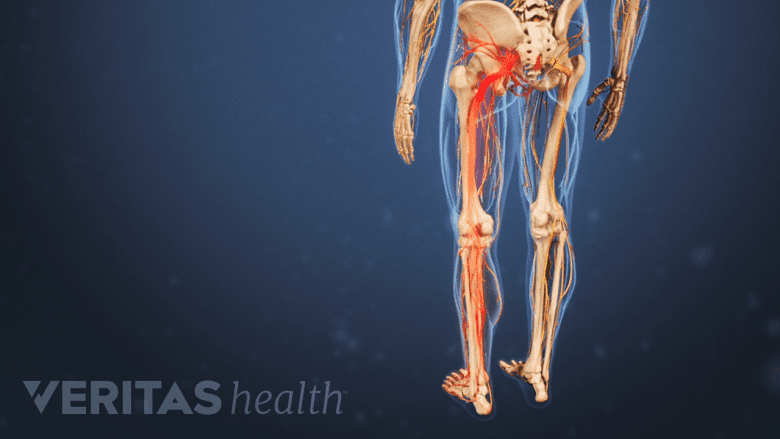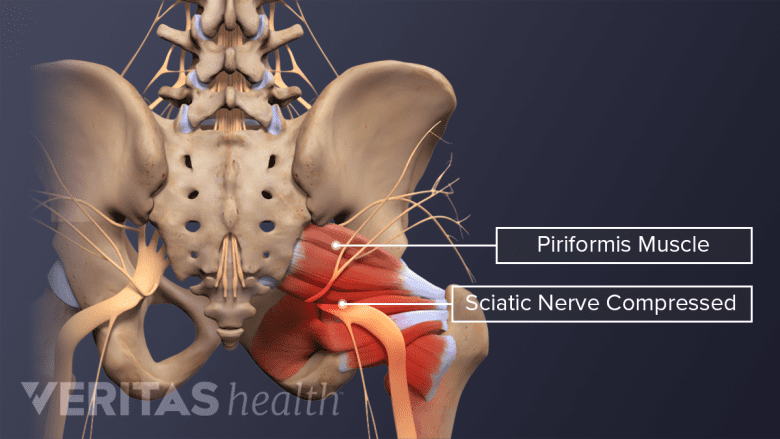Blood vessels in the legs may get infected, bulged, ruptured, or blocked, which in turn can cause sciatica-like signs and symptoms, such as leg pain, weakness, and numbness. It is possible, though rare, that these problems are a medical emergency needing immediate treatment to save the affected limb.
In This Article:
- When Sciatica Pain Is a Medical Emergency
- Spinal Cord Conditions with Sciatica Symptoms
- Spinal Tumors and Sciatica Symptoms
- Blood Vessel Conditions Causing Sciatica Symptoms
- Sciatica Causes and Symptoms Video
Acute Limb Ischemia
Acute limb ischemia may present with severe pain and weakness in the affected limb, similar to sciatica pain.
This condition occurs due to decreased or loss of blood supply to the legs. Leg pain in acute limb ischemia may feel similar to sciatica pain, and the symptoms may progress quickly and become severe.1Brearley S. Acute leg ischaemia. BMJ. 2013;346(may08 1):f2681-f2681. doi:10.1136/bmj.f2681
Acute limb ischemia may produce one or more of the following additional signs and symptoms:
- Pain and numbness in the leg at rest and/or while walking
- Severe pain at night causing disturbed sleep
- Pain relief experienced while sitting on a chair with the feet hanging down
- Swelling in the feet and ankles
- Pale color and less warmth in the skin over the toes and feet compared to the legs
Acute limb ischemia may develop due to an aneurysm (bulge in the wall of the blood vessel), blood clot, or due to the thickening of the vessel walls. It is important to treat acute limb ischemia promptly in order to preserve leg function.
When differentiating between vascular and other causes (such as spinal problems) of leg pain, an Ankle/Brachial Index (comparison of blood flow in the arms vs legs) is often critical in determining if vascular insufficiency exists.
Acute Compartment Syndrome
Acute compartment syndrome occurs due to increased pressure in the buttock that compresses the sciatic nerve.
This syndrome causes increased pressure within the muscle tissues of the leg, leading to loss of blood supply to the affected region. The sciatic nerve may get compressed due to the increased pressure in the buttock, thigh, and/or leg. The condition may cause pain, numbness, and weakness in the buttock, thigh, and/or leg, along with altered sensation in the web of the great toe—similar to sciatica.2Alobaidi A, Backdash MM, El-Menyar A. Thigh compartment syndrome complicated by sciatic nerve palsy, rhabdomyolysis, and acute renal failure. Clin Case Rep. 2015;4(2):107–110. Published 2015 Nov 19. doi:10.1002/ccr3.446 One or both legs may be affected.
A few differentiating signs and symptoms include:
- Swelling in the leg
- Pain and tenderness on touching the leg
- Pale color and less warmth in the skin over the leg
Acute compartment syndrome is a serious development and constitutes a medical emergency. If not treated promptly, it is possible for the condition to cause complete dysfunction of the limb.
The presence of certain risk factors may increase the chances of developing limb ischemia or compartment syndrome, such as smoking, diabetes, heart conditions, and high cholesterol. A previous history of the condition may also cause a recurrence due to injury or poor health.
Kidney problems, such as kidney stones, chronic renal failure, or cysts in the kidney may cause back pain and leg pain along with other signs, such as blood in the urine or difficulty in passing urine.
As a general guideline, any sign of troubling symptoms or signs that occur along with sciatica indicates the need for medical attention to check for the possibility of a severe underlying condition or medical emergency. Treating medical emergencies promptly can help preserve tissue, restore function, and even save the person’s life.
Read more: 2 Sciatica Symptoms That Require Immediate Medical Attention
- 1 Brearley S. Acute leg ischaemia. BMJ. 2013;346(may08 1):f2681-f2681. doi:10.1136/bmj.f2681
- 2 Alobaidi A, Backdash MM, El-Menyar A. Thigh compartment syndrome complicated by sciatic nerve palsy, rhabdomyolysis, and acute renal failure. Clin Case Rep. 2015;4(2):107–110. Published 2015 Nov 19. doi:10.1002/ccr3.446







